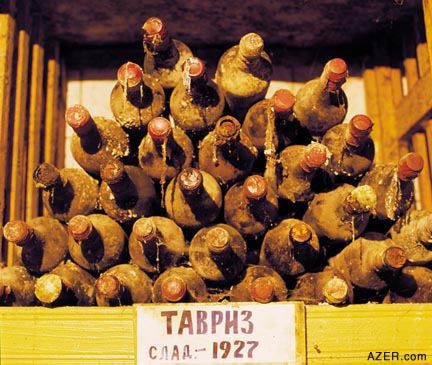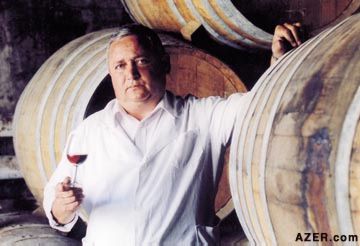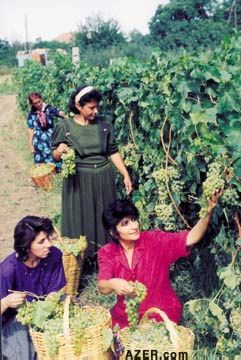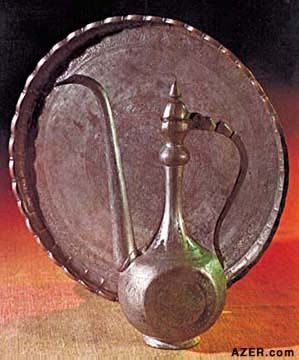|

Autumn 2000 (8.3)
Pages
38-41
Ancient Wines
Exactly
What the Doctor Ordered
by
Farid Alakbarov

Above:
Sweet wine
from Tabriz, vintage 1927. Photo: Huseinzade
"There is no greater virtue than reason and sobriety, nor
any evil worse than recklessness and hard drinking," wrote
Nasir-al-din Tusi (1201-1274), the famous Azerbaijani scientist
and founder of the Maragha observatory in Southern Azerbaijan
(in present-day Iran). However, scholars of the Middle Ages recommended
special kinds of wine for medical proposes. "Of course,
the moderate use of wine is good for the stomach and other organs,
but its overuse is harmful and dangerous. You repeatedly have
observed drunken persons and have been correct in having an aversion
to them," points out Ibn Sina (980-1137), more familiarly
known as Avicenna in the West and father of the first comprehensive
medical treatise, "Canon of Medicine."
_____
History of Wine-making
Wine-making in Azerbaijan dates back to ancient times. Various
sorts of grapes have been cultivated throughout the Middle East
since then. In the Khanlar district of the Azerbaijan Republic,
for example, archeologists have found jars buried with the remains
of wine dating back to the 2nd millennium BC. Assyrian cuneiform
sources from the 7th century BC describe storehouses for wine
in the Kingdom of Manna, which was located in what is now Southern
Azerbaijan. Sargon II, who ruled Assyria between 722-705 BC,
once said: "When I was attacking my enemies...Ullusunu,
the King of Manna, supplied my troops with wheat and wine."
According to the ancient Greek historian Strabo (born in 64/63
BC and died after 23 AD), people living in Northern Azerbaijan
(Caucasian Albania at that time) cultivated such abundant crops
of grapes that they were not able to harvest them.
The medieval epic poem "Kitabi Dada Gorgud" (Book of
Dada Gorgud), developed between the 7th-11th centuries AD, describes
scenes of wine-making: "There are gardens in our mountains
where branches of black grapes grow. We squeeze the juice from
these grapes and make red wine. Those who drink this wine, become
drunk." Historical sources suggest that during the 13th-14th
centuries the annual harvest of grapes from orchards around Tabriz
(Southern Azerbaijan) was about 150 tons.
However, the medieval wines of Azerbaijan were not like contemporary
wines. They were concentrated and sweet as honey. Usually, people
of those times used concentrated, strong wines. It was impossible
to drink pure wine because it was so thick. That's why people
diluted it with water ("mey" in Azeri).
About 10 years ago, the residents of the town of Shamakhi (about
two hours north of Baku) unearthed a huge ancient ceramic jar
with a thick syrup in it. They tasted the syrup and discovered
that it was a very concentrated, fragrant wine.
  Wine made from grapes
was called "sharab"; from other fruits (such as apples,
pomegranates and mulberry), it was known as "nabiz".
In addition, many types of wines were named "chakhir." Wine made from grapes
was called "sharab"; from other fruits (such as apples,
pomegranates and mulberry), it was known as "nabiz".
In addition, many types of wines were named "chakhir."
Left: Cognac aging in
oaken barrels. Khanlar region. Photo: Litvin
Historical sources have preserved the names of the wine brands
used in Azerbaijan during the Middle Ages. They include: Reyhani,
Jumhuri, Mishmish, Valani, Arastun, Handigun and Salmaveyh. None
of these names are used today, having been replaced by brand
names that include: Shahdagh, Chinar, Sadili, Aghdam, Kurdamir,
Agstafa and Madrasali.
Common Wines
During the Middle Ages consumption of wine was strictly prohibited
by Islam; however, wine was used, especially by the ruling class.
The famous writer and landowner from the southern coast of the
Caspian, Keikavus Ibn Isgandar (10th century) wrote his son a
letter: "I'm not telling you: 'Stop drinking wine,' because
I know young people will not follow the advice of their elders.
I was given the same advice, but didn't pay any attention to
my own elders' words. Only now that I am 50 years old has God
taken pity upon me so that I could quit drinking."
In the Middle Ages, some representatives of the nobility in Azerbaijan
used wine to alleviate tiredness and entertain their guests.
In 1669, Muhammad Mu'min, Court Physician to Shah Suleyman Safavi,
advised wealthy people in arranging healthy wine-feasts ("sharab
majlisi"): "To entertain and alleviate physical tiredness,
it is possible to arrange feasts and drink wine, but not more
frequently than once or twice a month. However, you should take
into account whether you were in good health or not.
The feast should be arranged in a flowering garden amidst fragrant
air and fountains. Invite musicians, singers and dancers. You
should sit with clever, honest friends and listen to music, songs
or poetry. Don't be boring and dull, entertain your friends by
quoting poetry or telling interesting stories. When telling jokes,
be careful not to offend anyone..."
Medical Wines
Wines were used for medical purposes as well. For example, Yusif
Khoyi (1311) points out: "Small doses of medical wines strengthen
the sense organs and the whole body. Medical wines treat melancholy,
depression and bad moods. They decrease anger and nervousness,
make humans more brave and generous and counter the effects of
various poisons. Wines diluted with water are good against fever
and cold." Below are some examples of medical wines described
in books written in the Middle Ages:
  Rose Petal Wine Rose Petal Wine
According to "Tibbname" (Book of Medicine, 18th century)
rose petal wine was recommended against headaches, heart disease,
stomach pain and fever.
Left:
Grape harvest.
Photo: Litvin
Recipe: Take 600 grams dried rose petals and tie in a little
cloth pouch. Then place this pouch in a jar of 10 liters of grape
juice and young wine. Cover the jar securely and keep in the
shade for three months. Then filter the wine, pour it into another
jar and store again.
Salty Wine
According to Hasan Ibn Reza Shirvani (17th century), this wine
was used to treat chronic fever and constipation. It was also
used as a diuretic, for the stomach, to alleviate pain in the
joints and kidneys and to stimulate the appetite. It was especially
recommended for elderly people.
Recipe: Mix equal parts of sour grape juice with honey and 1/4
part of salt. Then pour the mixture into a jar and allow to mature
for several months until the wine is ready.
Celery-seed Wine
Muhammad Mu'min (17th century) writes that this wine stimulates
the appetite, is good for digestion and serves as a diuretic,
eliminating waste substances.
Recipe: Crush 260 grams of celery seeds, filter and place in
a linen pouch inside a jar containing 1 liter of grape juice.
Allow to mature for at least three months.
Treatment with
Wine
Physicians of the Middle Ages used wines to treat various diseases.
Here are some examples of their recommendations:
Mouth Ulcers
There is evidence that wine was used as an antiseptic. It was
recommended to rinse the mouth with a strong, dry, sour-tasting
wine. Both red and white sour wines were used. Treatment had
to be continued for several days.
Sore Throat
It was recommended to gargle with warm, sour, dry wine, preferably
lemon, pomegranate, salty or quince medical wines. After gargling,
no eating or drinking was permitted for about 20-30 minutes.
Ear Inflammation
To treat pain and inflammation in children's ears, it was recommended
to put a piece of cotton soaked in strong, old wine into the
infected ear. It was believed that such treatment on a regular
basis would heal the inflammation.
Anemia
According to "Tibbname" (Book of Medicine, 1712) anyone
suffering from anemia should eat more meat and nutritious foods
and drink sweet red wine. It was believed that red wine was transformed
into blood in the organism. Modern scientists have since confirmed
that moderate use of port (sweet red wine) is good in treating
anemia. Azerbaijani ports such as Kurdamir, Gizil Sharbat and
Mil are sometimes used to treat anemia in Azerbaijan.
Flatulence and
Gas
To prevent indigestion and flatulence, it was recommended to
drink some wine prior to eating. Medical wine of bitter wormwood
resembling the modern absinthe (liqueur of wormwood) was used
as a remedy against flatulence.
  Frostbite Frostbite
On cold days, it was recommended to drink wine instead of water
before leaving home. Ibn Sina (980-1037) writes that medical
wine to which the herb "ferula" (fennel family) had
been added would effectively heat up the body.
Left:
Wines were
often prescribed by physicians during the medieval era, for ailments
that ranged from anemia to lack of appetite. The above vessel,
called an "aftafa", was used to hold wine, water, rosewater,
sharbat and other beverages.
Fever
To treat fever brought on by malaria, Muhammad Husein Khan (18th
century) advised the use of so-called Spicy Wine. In addition,
rose petal wine and Arastun wine were considered effective treatment
against various kinds of fevers.
Lack of Appetite
To stimulate the appetite, it was recommended to drink some spicy
wine, especially with honey. Fragrant wine was believed to stimulate
the creation of gastric juice, which facilitates the digestion
of food. The wine brand named Reihani was used to stimulate the
appetite as well.
Medical wines were not necessarily alcoholic beverages, but resembled
more the modern herbal infusions, such as valerian or mint infusions,
based on spirits that are sold in modern drugstores. In general,
medical wines that were once quite prevalent in Azerbaijan are
mostly forgotten today. However, I'm convinced that it is possible
to revive them and, after carrying out necessary scientific studies
and trials, to incorporate them into modern valid medical practice.
For the past
15 years, Farid Alakbarov has been studying the medical
manuscripts in Arabic script which are archived at Baku's Institute
of Manuscripts (See Summer 2000, AI 8.2, p. 51). SEARCH at AZER.com.
_____
From Azerbaijan
International
(8.3) Autumn 2000.
© Azerbaijan International 2000. All rights reserved.
Back to Index
AI 8.3 (Autumn 2000)
AI Home
| Magazine Choice | Topics
| Store
| Contact
us
|




